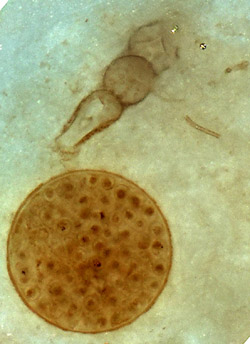Spoilt attack in the Lower Devonian
The Rhynie chert is well known as a source of discoveries but the one
seen in this picture is one of the least expected.
The unique scene features a rotifer approaching a spherical alga
(?) superficially resembling extant Volvox.
Extant rotifers are known to snatch individual cells from Volvox
spheres to eat them. Now we may conclude that this snatching mode of
grazing
has been
going on for at least 400 million years.

Image: Oldest rotifer ever seen, caught in the act of attacking a
spherical
alga colony:
snapshot of freshwater life in
the Lower Devonian,
facilitated by rapid formation of
silica gel in a shallow pool;
sphere size 0.14mm;
photograph by H. Eschrich,
Carl Zeiss MicroImaging GmbH.
The placement of this sphere into an established
clade is problematic.
There are only a few species with the habit of spherical colonies among
the vast numbers of Green Algae, Golden Algae, and even the basically
different Blue-green Algae (Cyanobacteria).
An interpretation as a volvocacean sphere as suggested by a
first look at the scene is not justified for the following reasons:
Extant volvocacean spheres are hollow, and so is the Upper
Devonian marine alga Eovolvox
silesiensis [1], but this sphere is not. The cells
of volvocaceans are interconnected by plasma
filaments, which is also seen in the
Carboniferous species Lageniastrum
macrosporae [2], but no connections are seen here.
A possible affiliation with the
cyanobacteria has to be considered [3,4].
The sphere has been cut
right through its centre so that its outer sheath is distinctly seen in
cross-section. From the distribution of the cells it can be concluded
that there were about 500 in the whole sphere.
The rotifer, too, is the only
specimen of its kind found in the Rhynie chert. The oldest reported
fossil rotifers [3] were found in amber dating to the Tertiary (*). The
distinct features of the present fossil specimen and its great age
compared to any other known rotifer may justify regarding it as a new
species.
The rotifer is tilted with respect to
the cut plane. A stack of pictures taken by H. Eschrich with
confocal
imaging is available for a 3D reconstruction.
The dramatic scene featuring rotifer
and alga is set among flooded and decayed terrestrial vegetation,
probably Rhynia.
Apparently the attack was spoilt by quick formation of
silica gel making the rotifer get stuck before it could harm the
alga. One even can tell what came next: The aggressive rotifer
was bound to
starve while the peaceful alga went on living within the gel where it
was provided with all necessities of life via diffusion.
It has been an extremely lucky
incidence to have got this scene on the cut and polished chert
face, preserved for eternity in
a nearly optimal constellation, considering that
- cutting, grinding, and polishing had been done
unawares of these fossils,
- the plane cuts right through the centre of the
sphere,
- the rotifer has not been damaged, except for a
tiny part of the head cut off,
- these two organisms have never been seen
separately.
The inconspicuous small chert sample of 90g was found by my wife, Sieglinde Weiss,
well away from the protected chert site.
It is hoped that
more specimens will be found so that the two new species
can be properly characterized.
H.-J. Weiss
2008
[1] J.
Kazmierczak: The biology and evolutionary significance
of Devonian volvocaceans and their Precambrian relatives.
Acta Palaeont. Polonica 26(1981),
299-337.
[2] M. Krings
et al.: Lageniastrum
macrosporae (fossil Volvocales, ...), an
endophyte in megaspores from the Carboniferous ...
Geobios 38(2005), 451-65.
[3] J.
Kazmierczak: private communication
[4] Robert Lee:
private communication
[5] B.M.
Waggoner, G.O. Poinar:
Fossil habotrochid rotifers found in Dominican amber.
Experientia (Basel) 49(1993), 354-7.
Annotation:
The subject had been presented at the 8th IOPC Conference, Bonn 2008
[6], and on a friend's
website where it is still seen [7].
[6] H.-J. Weiss
: Two spherical algae of different design in
the Lower Devonian,
poster abstract: Terra Nostra 2008/2,
303.
[7] H. Steur
: http://www.xs4all.nl/~steurh/
* Annotation 2012: The recent discovery of well preserved
rotifers much older than those in [5] has been reported by N. Jha et
al. [8]. Obviously unawares of the Devonian rotifer presented here,
which is still the only specimen from the Rhynie chert and has not been
published in the scientific literature, they regarded theirs as the
oldest fossil rotifer.
[8] N.
Jha, P. Kumar, N. Aggarwal, D.D. Bhattacharyya, A.C. Pande: The
oldest bdelloid rotifera from Early Permian sediments ...
Int. J. Geol. Earth Environm. Sci.
(Online) 1(2011), 23-29.
Annotation 2014:
Two specimens of the small
crustacean Ebullitiocaris
pictured in Paleobotany
[9], Fig.1.57, are called "rotifers
from the Rhynie chert" in the text beneath.
The error had been addressed in [10].
[9] T.N. Taylor,
E.L.Taylor, M. Krings: Paleobotany, Elsevier 2009, 30.
[10] H.-J.
Weiss: Rhynie chert - Implications of new
finds. European Palaeobotany and Palynology Conference 2014,
Padua.
 |
 |
23 |




